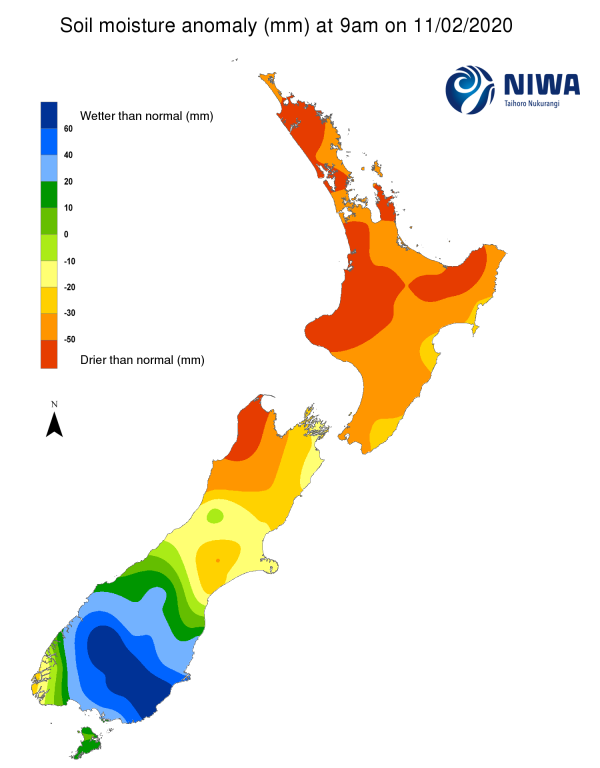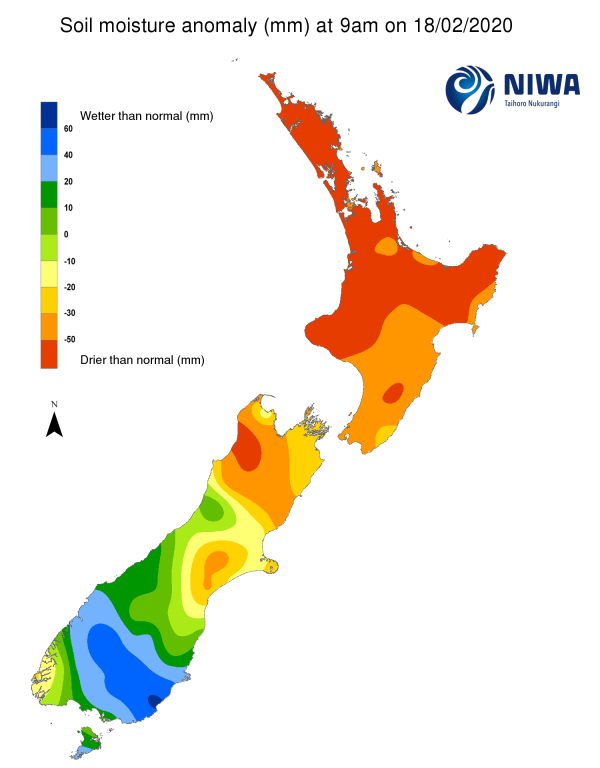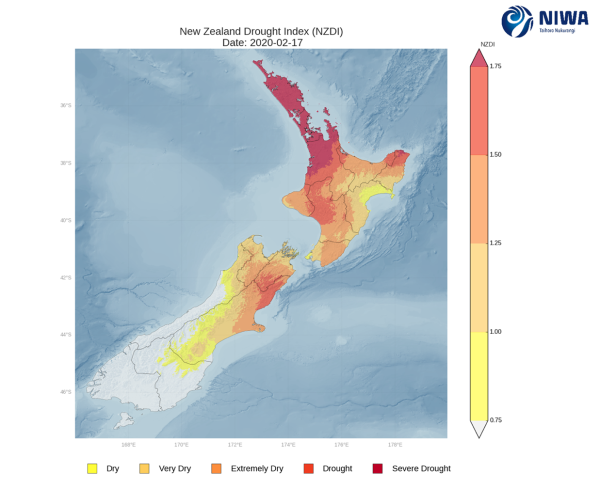A weekly update describing soil moisture patterns across the country to show where dry to extremely dry conditions are occurring or imminent. Regions experiencing significant soil moisture deficits are deemed “hotspots”. Persistent hotspot regions have the potential to develop into drought.
Facts: soil moisture
Across the North Island, the past week featured little if any rainfall (<5 mm) for nearly all locations as high pressure remained anchored overhead. Only areas from southern Manawatu-Whanganui to Wellington received slightly higher rainfall amounts. The driest soils across the North Island, when compared to normal for this time of the year, are generally found from Northland to the Central Plateau and East Cape west to Taranaki, while the least dry soils for this time of the year are located in a small portion of Wairarapa. The New Zealand Drought Index (NZDI) shows that the upper North Island has widespread severe meteorological drought, with meteorological drought also affecting central Waikato to Manawatu-Whanganui as well as East Cape.
Nearly all of the North Island has reached official hotspot status, with only a few isolated areas that have not quite reached hotspot criteria.
The past seven days brought moderate to even heavy rain to parts of the West Coast, while generally 10-20 mm was observed in Tasman and the lower South Island. Meanwhile, only meagre rainfall amounts occurred from Marlborough south to around Dunedin. The driest soils in the South Island compared to normal for this time of the year are located across parts of Buller District and southern Tasman, while the wettest soils for this time of the year are found across Otago and Southland. The New Zealand Drought Index (NZDI) shows that meteorological drought is now found across coastal Hurunui and southern Kaikoura.
Current hotspots in the South Island now include Nelson and nearby parts of Tasman, much of Marlborough, along with northern Canterbury, Banks Peninsula, and parts of Ashburton and Selwyn districts.
Outlook and soil moisture
In the North Island, drier than normal conditions are likely to continue for many locations during the next week. Scattered showers and thunderstorms in Hawke’s Bay, Gisborne, and eastern Bay of Plenty this afternoon (19 February) may produce isolated amounts of 10-15 mm. On Saturday (22 February), a passing front is likely to produce widespread 5-15 mm across the western and northern North Island, with lesser amounts farther east. Thereafter, high pressure will again dominate the North Island’s weather with little if any rainfall through the middle of next week.
Although rainfall amounts in the next week are likely to be higher than recent weeks for many parts of the North Island, significant soil moisture increases are not expected. While a few areas may see small improvements, locations in the southern and eastern North Island may in fact see additional soil moisture decreases.
In the South Island, a front will move up the West Coast on Friday (21 February), producing widespread rainfall amounts of 30-60 mm, with higher amounts at higher elevations. On Saturday, parts of Canterbury could receive 10-15 mm. Thereafter, high pressure will bring dry weather to the South Island through the middle of next week.
Soil moisture levels may show small increases from Tasman to Fiordland due to expected rainfall in the next week. In addition, soil moisture levels in eastern parts of the South Island may not change significantly due to the moderate rainfall anticipated on Saturday. Overall, hotspots from Tasman to Nelson and across Canterbury may slightly weaken during the next week, while those in eastern Marlborough may strengthen.
Background
Hotspot Watch: a weekly advisory service for New Zealand media. It provides soil moisture and precipitation measurements around the country to help assess whether extremely dry conditions are imminent.
Soil moisture deficit: the amount of water needed to bring the soil moisture content back to field capacity, which is the maximum amount of water the soil can hold.
Soil moisture anomaly: the difference between the historical normal soil moisture deficit (or surplus) for a given time of year and actual soil moisture deficits.
Definitions: “Extremely” and “severely” dry soils are based on a combination of the current soil moisture status and the difference from normal soil moisture (see soil moisture maps).
Hotspot: A hotspot is declared if soils are "severely drier than normal" which occurs when Soil Moisture Deficit (SMD) is less than -110 mm AND the Soil Moisture Anomaly is less than -20 mm.
Soil Moisture Anomaly Maps, relative to this time of year. The maps show soil moisture anomaly for the past two weeks.
As of 17 February, the New Zealand Drought Index (NZDI) map below shows that all of the upper North Island is experiencing severe meteorological drought, while central Waikato to Manawatu-Whanganui and East Cape have entered meteorological drought. In the South Island, meteorological drought is now found across northern Canterbury with widespread extremely dry soils elsewhere.
Please note: some hotspots in the text above may not correspond with the NZDI map. This difference exists because the NZDI uses additional dryness indices, including one which integrates the rainfall deficit over the past 60 days. Changes are therefore slower to appear in the NZDI compared to soil moisture anomaly maps that are instantaneously updated.




